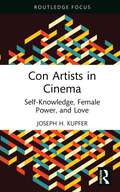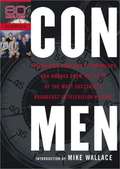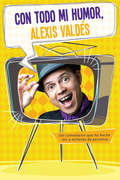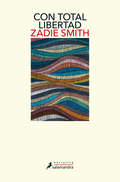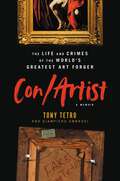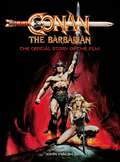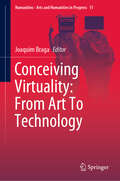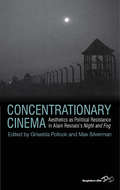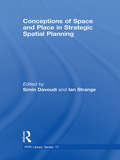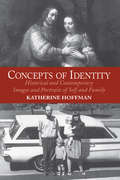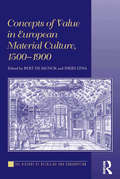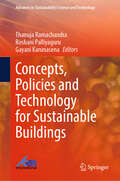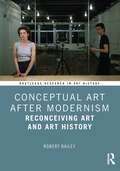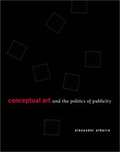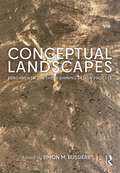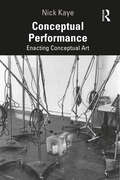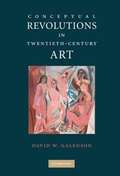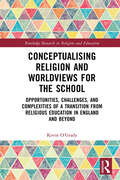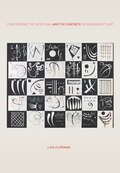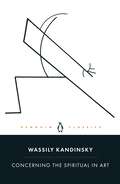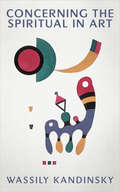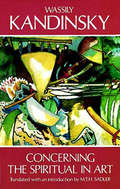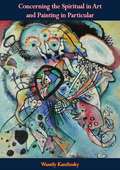- Table View
- List View
Con Artists in Cinema: Self-Knowledge, Female Power, and Love (Routledge Focus on Film Studies)
by Joseph H. KupferThis book examines the con artist film as a genre, exploring its main features while also addressing variations within it. The volume explores three diverse themes of the con artist film: edification, self-awareness, and liberation through con games; the femme fatale as con artist; and romantic love as a plot point. Analyzing movies such as Matchstick Men (2003), House of Games (1987), Body Heat (1981), The Last Seduction (1994), Birthday Girl (2001), and The Game (1997), the book also explores their psychological investigation of the con artist figure, the con artist’s mark, and how the dynamic between these roles implicates us as the audience. It also addresses the con artist film genre’s close association with neo-noir, especially through the femme fatale figure, investigating and updating the rich tradition of noir film. Demonstrating the range and flexibility of this understudied genre, this book will be of interest to scholars and students of film studies, ethics, and those studying the representation of women in film..
Con Men: Fascinating Profiles of Swindlers and Rogues from the Files of the Most Successful Broadcast in Television History
by Ian Jackman60 Minutes brings its award-winning journalistic skills and unmistakable broadcast style to the page, delving into its archives to present stories on one of the program's most popular subjects: the con man. Con Men exposes a truly eclectic group of swindlers and rogues: the extraordinary characters of ABSCAM, pyramid-scheme millionaires and stock-market crooks, snake-oil salesmen and art forgers. Many of them are diabolical -- all of them are intriguing. Here 60 Minutes captures each one in vivid det...
Con todo mi humor, Alexis Valdés: Del comediantes que ha hecho reír a millones de personas
by Alexis ValdésEn Con todo mi humor, Alexis Valdés, el conocido humorista y actor Alexis Valdés cuenta la historia y los pasajes más divertidos de su vida a través de anécdotas y monólogos de humor. Los lectores reirán a carcajadas al enterarse por qué Alexis Valdés viajó a Etiopía, cómo logró el personaje de Bandurria y cómo logró colarse Cristinito con su monólogo. Este es un libro para reír. Este es el libro que tantos admiradores de la buena comedia han estado esperando. En Con todo mi humor, Alexis Valdés, el entrañable comediante cubano nos invita a una tertulia en la que habla sin censura, contándonos todo lo que en televisión no ha podido decir. Las anécdotas que comparte sobre su vida nos ayudan a comprender de dónde le viene esa asombrosa capacidad para encontrar humor en toda situación, sin importar lo difícil o dolorosa que sea. ¿Quién puede hacernos reír con el relato de un viaje hasta el desierto de Etiopíaque casi le cuesta la vida? Sólo Alexis Valdés. Cada página nos hará reír a carcajadas y, como bien dice Alexis Valdés al final de este divertidísimo libro: «Seguramente, cuando me vuelvan a ver en televisión, en el cine, en el teatro, sonreirán de otra manera, más cómplice, y dirán: "A este tipo yo lo conozco bastante bien"».
Con total libertad
by Zadie SmithUn libro cargado de agudeza, frescura y empatía que nos ilumina en un mundo cada vez más cambiante y contradictorio. Zadie Smith ha demostrado ser una ensayista brillante y singular, haciendo que cada texto suyo sea un acontecimiento literario por derecho propio. Con total libertad, que recopila algunos de los más celebrados, abarca el amplísimo rango de intereses de Smith: desde todas las facetas de la cultura y la libertad artística hasta los temas más acuciantes de la política y la actualidad, siempre desde una perspectiva original y radicalmente personal. Gracias a su fina agudeza, una frescura contagiosa y una empatía extraordinaria, este libro es una guía imprescindible para entender un mundo, el nuestro, cada vez más complejo y contradictorio. La crítica ha dicho:«Ecléctica en sus gustos y centrífuga en su estilo, Zadie Smith disfruta, como articulista, de ampliar los límites de su pensamiento [...] En la línea de Hazlitt y Orwell, Woolf y Angela Carter.»The Financial Times «Interesante, sagaz [...]¿Se debe leer este libro brillante? ¡Por supuesto que sí!»The Independent «Un libro inteligente, ingenioso y a menudo hilarante que demuestra que (Zadie Smith) es una de las mentes más brillantes de la literatura británica de hoy en día.»NPR «Es un placer exquisito observar a Zadie Smith pensar a lo largo de estas páginas.»The New York Times Book Review «Smith lleva a la escritura de artículos sus dotes como novelista: buen ojo para el detalle, sutiles giros en las frases.»The Boston Globe «Estos ensayos en su conjunto reflejan una mente abierta, vivaz, natural, rigurosa, erudita y seria, ocupada en perfeccionar su manera de ver la vida, la literatura y la relación entre ambas. Smith demuestra que es mucho más que una cabeza adulta y comprensiva sobre unos hombros muy jóvenes. Y lo demuestra con su apasionada, compulsivamente dialéctica y atractiva indagación de la literatura».Los Angeles Times «No importa sobre lo que escriba -su padre, Kafka, Liberia, George Clooney-: colocar cualquier tema dentro del campo magnético de su cerebro incansable basta para volverlo fascinante. Smith [...] tiene el don de mostrarnos cómo lee y piensa; al ver cómo lo hace, uno se siente a su vez más inteligente y observador por ósmosis.»Time
Con/Artist: The Life and Crimes of the World's Greatest Art Forger
by Tony Tetro Giampiero AmbrosiThe world&’s most renowned art forger reveals the secrets behind his decades of painting like the masters—exposing an art world that is far more corrupt than we ever knew while providing an art history lesson wrapped in sex, drugs, and Caravaggio. The art world is a much dirtier, nastier business than you might expect. Tony Tetro, one of the most renowned art forgers in history, will make you question every masterpiece you&’ve ever seen in a museum, gallery, or private collection. Tetro&’s &“Rembrandts,&” &“Caravaggios,&” &“Miros,&” and hundreds of other works now hang on walls around the globe. In 2019, it was revealed that Prince Charles received into his collection a Picasso, Dali, Monet, and Chagall, insuring them for over 200 million pounds, only to later discover that they&’re actually &“Tetros.&” And the kicker? In Tony&’s words: &“Even if some tycoon finds out his Rembrandt is a fake, what&’s he going to do, turn it in? Now his Rembrandt just became motel art. Better to keep quiet and pass it on to the next guy. It&’s the way things work for guys like me.&” The Prince Charles scandal is the subject of a forthcoming feature documentary with Academy Award nominee Kief Davidson and coauthor Giampiero Ambrosi, in cooperation with Tetro. Throughout Tetro&’s career, his inimitable talent has been coupled with a reckless penchant for drugs, fast cars, and sleeping with other con artists. He was busted in 1989 and spent four years in court and one in prison. His voice—rough, wry, deeply authentic—is nothing like the high society he swanned around in, driving his Lamborghini or Ferrari, hobnobbing with aristocrats by day, and diving into debauchery when the lights went out. He&’s a former furniture store clerk who can walk around in Caravaggio&’s shoes, become Picasso or Monet, with an encyclopedic understanding of their paint, their canvases, their vision. For years, he hid it all in an unassuming California townhouse with a secret art room behind a full-length mirror. (Press #* on his phone and the mirror pops open.) Pairing up with coauthor Ambrosi, one of the investigative journalists who uncovered the 2019 scandal, Tetro unveils the art world in an epic, alluring, at times unbelievable, but all-true narrative.
Conan the Barbarian: The Official Story of the Film
by John WalshOfficial retrospective hardback book telling the story of the making of Conan The Barbarian, including interviews with cast and crew and featuring behind-the-scenes photography from the shoot.In 1982, Robert E. Howard's iconic literary anti-hero, Conan, slashed his way from page to screen after a perilous decades-long journey. With its potent mix of epic vistas and bloody battles, Conan the Barbarian thrilled moviegoers around the world and launched the career of Arnold Schwarzenegger. Forty years after its release, this cult-classic film is celebrated in Conan the Barbarian – The Official Story of the Film, a lush hardback volume that tells the full story of how the film was made. Brand new interviews with cast and crew, as well behind-the-scenes photography from the set and concept art created for the production, give fascinating insights into the development of one of the best-loved fantasy films of the 1980s.
Conceiving Virtuality: From Art To Technology (Numanities - Arts and Humanities in Progress #11)
by Joaquim BragaThis book provides new theoretical approaches to the subject of virtuality. All chapters reflect the importance of extending the analysis of the concept of “the virtual” to areas of knowledge that, until today, have not been fully included in its philosophical foundations. The respective chapters share new insights on art, media, psychic systems and technology, while also presenting new ways of articulating the concept of the virtual with regard to the main premises of Western thought. Given its thematic scope, this book is intended not only for a philosophical audience, but also for all scientists who have turned to the humanities in search of answers to their questions.
Concentrationary Cinema
by Griselda Pollock Max SilvermanSince its completion in 1955, Alain Resnais's Night and Fog (Nuit et Brouillard) has been considered one of the most important films to confront the catastrophe and atrocities of the Nazi era. But was it a film about the Holocaust that failed to recognize the racist genocide? Or was the film not about the Holocaust as we know it today but a political and aesthetic response to what David Rousset, the French political prisoner from Buchenwald, identified on his return in 1945 as the 'concentrationary universe' which, now actualized, might release its totalitarian plague any time and anywhere? What kind of memory does the film create to warn us of the continued presence of this concentrationary universe? This international collection re-examines Resnais's benchmark film in terms of both its political and historical context of representation of the camps and of other instances of the concentrationary in contemporary cinema. Through a range of critical readings, Concentrationary Cinema explores the cinematic aesthetics of political resistance not to the Holocaust as such but to the political novelty of absolute power represented by the concentrationary system and its assault on the human condition.
Conceptions of Space and Place in Strategic Spatial Planning (RTPI Library Series)
by Ian Strange Simin DavoudiBringing together authors from academia and practice, this book examines spatial planning at different places throughout the British Isles. Six illustrative case studies of practice examine which conceptions of space and place have been articulated, presented and visualized through the production of spatial strategies. Ranging from a large conurbation (London) to regional (Yorkshire and Humber) and national levels, the case studies give a rounded and grounded view of the physical results and the theory behind them. While there is widespread support for re-orienting planning towards space and place, there has been little common understanding about what constitutes ‘spatial planning’, and what conceptions of space and place underpin it. This book addresses these questions and stimulates debate and critical thinking about space and place among academic and professional planners.
Concepts of Identity: Historical and Contemporary Images and Portraits of Self and Family
by Katherine Hoffman<p>Concepts of identity are complex and changing, and in this book Katherine Hoffman examines images of individuals and families from ancient Egypt to the present—more than two thirds of the book covers the twentieth century. Through a comprehensive study of paintings, sculpture, photography, film, television, and other media, Hoffman provides eye-opening insights on the identity of family and self through time and explores what these images say about the attitudes and values of a particular culture. <p>Concepts of identity and self as individuals and families are complex and changing, but images from the artist, the photographer, the filmmaker, and TV producer can help us discover where we came from, who we are and why, and where we are in the maze of postmodern life. Katherine Hoffman explores portraits and images from ancient Egypt to the present—more than two-thirds of the book covers the twentieth century, including images from art, photography, film, TV, and other media. The 75 illustrations are integrated with the text.</p>
Concepts of Value in European Material Culture, 1500-1900 (The History of Retailing and Consumption)
by Bert De Munck Dries LynaIn contemporary society it would seem self-evident that people allow the market to determine the values of products and services. For everything from a loaf of bread to a work of art to a simple haircut, value is expressed in monetary terms and seen as determined primarily by the 'objective' interplay between supply and demand. Yet this 'price-mechanism' is itself embedded in conventions and frames of reference which differed according to time, place and product type. Moreover, the dominance of the conventions of utility maximising and calculative homo economicus is a relatively new phenomenon, and one which directly correlates to the steady advent of capitalism in early modern Europe. This volume brings together scholars with expertise in a variety of related fields, including economic history, the history of consumption and material culture, art history, and the history of collecting, to explore changing concepts of value from the early modern period to the nineteenth century and present a new view on the advent of modern economic practices. Jointly, they fundamentally challenge traditional historical narratives about the rise of our contemporary market economy and consumer society.
Concepts, Policies and Technology for Sustainable Buildings (Advances in Sustainability Science and Technology)
by Thanuja Ramachandra Roshani Palliyaguru Gayani KarunasenaThis book presents knowledge on sustainability concepts, policies, and technologies adopted in both developed and developing countries. The book covers five themes: (a) advancing sustainability building rating systems, (b) promoting retrofitting buildings and warranting energy-efficient buildings, (c) realizing water efficiency within building structures, (d) application of the circular economy to manage waste, and (e) enhancing the health and well-being of building occupants. The first theme includes case study-based evidence and solutions to different rating systems used in different countries. The second and third themes mainly focus on the achievement of sustainability under the key parameters of energy efficiency and water efficiency through the application of various techniques and technologies, such as green roofs, green walls, and grid-tied solar photovoltaic technology, with a special emphasis on retrofitting techniques, in different case study contexts. The fourth theme primarily addresses the need to clarify misconceptions surrounding the concept of the 'circular economy' within the construction industry. It explores its broader applications in various contexts, aiming to uncover opportunities for knowledge expansion and transfer across different countries. The fifth and final theme of the book addresses various good practices and tools developed to enhance the health and well-being of building occupants, with a primary focus on how such things help achieve sustainable buildings.
Conceptual Art After Modernism: Reconceiving Art and Art History (Routledge Research in Art History)
by Robert BaileyThis study provides a new interpretation of art after modernism by foregrounding the importance of conceptual thinking as a pervasive force for change in art and art history since 1950.Robert Bailey shows how distinctions between art and art history gave way as conceptual thinking provided artists and art historians with a common means to reassess what art could be and do in the world. Bailey assesses the results of artful and scholarly inquiries combining creative activity with intellectual rigor to proffer new approaches to a variety of social and environmental concerns, ranging from questions about human identity—including race, class, gender, and sexuality—to activist efforts to redress everything from abortion access to migrants’ rights, to climate change. This book provides both a historical overview of these developments and close analyses of key works and texts, spanning 1950 to the present and encompassing broad geographic scope with special attention paid to Indigenous art.The book will be of interest to scholars working in art history and contemporary art.
Conceptual Art and the Politics of Publicity
by Alexander AlberroConceptual art was one of the most influential art movements of the second half of the twentieth century. In this book Alexander Alberro traces its origins to the mid-1960s, when its principles were first articulated by the artists Dan Graham, Joseph Kosuth, Sol LeWitt, Lawrence Weiner, and others. One of Alberro's central arguments is that the conceptual art movement was founded not just by the artists but also by the dealer Seth Siegelaub. Siegelaub promoted the artists, curated groundbreaking shows, organized symposia and publications, and in many ways set the stage for another kind of entrepreneur: the freelance curator. Alberro examines both Siegelaub's role in launching the careers of artists who were making "something from nothing" and his tactful business practices, particularly in marketing and advertising. Alberro draws on close readings of artworks produced by key conceptual artists in the mid- to late 1960s. He places the movement in the social context of the rebellion against existing cultural institutions, as well as the increased commercialization and globalization of the art world. The book ends with a discussion of one of Siegelaub's most material and least ephemeral contributions, the Artist's Reserved Rights Transfer and Sale Agreement, which he wrote between 1969 and 1971. Designed to limit the inordinate control of collectors, galleries, and museums by increasing the artist's rights, the Agreement unwittingly codified the overlap between capitalism and the arts.
Conceptual Landscapes: Fundamentals in the Beginning Design Process
by Simon M. BussiereConceptual Landscapes explores the dilemma faced in the early moments of design thinking through a gradient of work in landscape and environmental design media by both emerging and well-established designers and educators of landscape architecture. It questions where and, more importantly, how the process of design starts. The book deconstructs the steps of conceptualizing design in order to reignite pedagogical discussions about timing and design fundamentals, and to reveal how the spark of an idea happens – from a range of unique perspectives. Through a careful arrangement of visual essays that integrate analog, digital, and mixed-media works and processes, the book highlights differences between diverse techniques and triggers debate between design, representation, technology, and creative culture in the field. Taken together, the book’s visual investigation of the conceptual design process serves as a learning tool for aspiring designers and seasoned professionals alike. By situating student work alongside that of experienced teachers and landscape architects, the book also demystifies outdated notions of individual genius and sheds new light on the nearly universally messy process of discovery, bridged across years and diverse creative vocabularies in the conceptual design process. Lavishly illustrated with over 210 full color images, this book is a must-read for students and instructors in landscape architecture.
Conceptual Performance: Enacting Conceptual Art
by Nick KayeConceptual Performance explores how the radical visual art that challenged material aesthetics in the 1960s and 1970s tested and extended the limits, character and concept of performance. Conceptual Performance sets out the history, theoretical basis, and character of this genre of work through a wide range of case studies. The volume considers how and why principal modes and agendas in Conceptual art in the 1960s and 1970s necessitated new engagements with performance, as well as expanded notions of theatricality. In doing so, this book reviews and challenges prevailing histories of Conceptual art through critical frameworks of performativity and performance. It also considers how Conceptual art adopted and redefined terms and tropes of theatre and performance: including score, document, embodiment, documentation, relic, remains, and the narrative recuperation of ephemeral work. While showing how performance has been integral to Conceptual art’s critiques of prevailing assumptions about art’s form, purpose, and meaning, this volume also considers the reach and influence of Conceptual performance into recent thinking and practice. This book will be of interest to scholars and students of theatre, performance, contemporary art, and art history.
Conceptual Revolutions in Twentieth-Century Art
by David W. GalensonFrom Picasso's Cubism and Duchamp's readymades to Warhol's silkscreens and Smithson's earthworks, the art of the twentieth century broke completely with earlier artistic traditions. A basic change in the market for advanced art produced a heightened demand for innovation, and young conceptual innovators - from Picasso and Duchamp to Rauschenberg and Warhol to Cindy Sherman and Damien Hirst - responded not only by creating dozens of new forms of art, but also by behaving in ways that would have been incomprehensible to their predecessors. Conceptual Revolutions in Twentieth-Century Art presents the first systematic analysis of the reasons for this discontinuity. David W. Galenson, whose earlier research has changed our understanding of creativity, combines social scientific methods with qualitative analysis to produce a fundamentally new interpretation of modern art that will give readers a far deeper appreciation of the art of the past century, and of today, than is available elsewhere.
Conceptualising Religion and Worldviews for the School: Opportunities, Challenges, and Complexities of a Transition from Religious Education in England and Beyond (Routledge Research in Religion and Education)
by Kevin O'GradyThis timely volume addresses current debates surrounding the transition from the teaching of religious education (RE) to the more holistic subject of Religion and Worldviews (R&W) in England, and posits criteria for best practice among educators in varied settings and in a broader international context. By examining empirical sources, governmental reports, and in particular the 2018 final report from the Commission on Religious Education (CORE), the volume suggests key principles needed to guide the transition and ensure that R&W is effectively integrated into curricula, pedagogy, and teaching resources to meet the needs of all student groups. By effectively conceptualising R&W, the volume gives particular attention to the intersections of the subject with democratic citizenship education, intercultural competence, and religious literacy. This text will benefit researchers, academics, and educators with an interest in religious education and teacher education as well as the philosophy and sociology of education more broadly. Those interested in education policy and politics, as well as citizenship and schooling in the UK, will also benefit from this volume.
Concerning Consequences: Studies in Art, Destruction, and Trauma
by Kristine StilesKristine Stiles has played a vital role in establishing trauma studies within the humanities. A formidable force in the art world, Stiles examines the significance of traumatic experiences both in the individual lives and works of artists and in contemporary international cultures since World War II. In Concerning Consequences, she considers some of the most notorious art of the second half of the twentieth century by artists who use their bodies to address destruction and violence. The essays in this book focus primarily on performance art and photography. From war and environmental pollution to racism and sexual assault, Stiles analyzes the consequences of trauma as seen in the works of artists like Marina Abramovic, William Pope. L, and Chris Burden. Assembling rich intellectual explorations on everything from Paleolithic paintings to the Bible's patriarchal legacies to documentary images of nuclear explosions, Concerning Consequences explores how art can provide a distinctive means of understanding trauma and promote individual and collective healing.
Concerning the Spiritual and the Concrete in Kandinsky's Art
by Lisa FlormanThis book examines the art and writings of Wassily Kandinsky, who is widely regarded as one of the first artists to produce non-representational paintings. Crucial to an understanding of Kandinsky's intentions is On the Spiritual in Art, the celebrated essay he published in 1911. Where most scholars have taken its repeated references to "spirit" as signaling quasi-religious or mystical concerns, Florman argues instead that Kandinsky's primary frame of reference was G. W. F. Hegel's Aesthetics, in which art had similarly been presented as a vehicle for the developing self-consciousness of spirit (or Geist, in German). In addition to close readings of Kandinsky's writings, the book also includes a discussion of a 1936 essay on the artist's paintings written by his own nephew, philosopher Alexandre Kojève, the foremost Hegel scholar in France at that time. It also provides detailed analyses of individual paintings by Kandinsky, demonstrating how the development of his oeuvre challenges Hegel's views on modern art, yet operates in much the same manner as does Hegel's philosophical system. Through the work of a single, crucial artist, Florman presents a radical new account of why painting turned to abstraction in the early years of the twentieth century.
Concerning the Spiritual and the Concrete in Kandinsky's Art
by Lisa FlormanThis book examines the art and writings of Wassily Kandinsky, who is widely regarded as one of the first artists to produce non-representational paintings. Crucial to an understanding of Kandinsky's intentions is On the Spiritual in Art, the celebrated essay he published in 1911. Where most scholars have taken its repeated references to "spirit" as signaling quasi-religious or mystical concerns, Florman argues instead that Kandinsky's primary frame of reference was G. W. F. Hegel's Aesthetics, in which art had similarly been presented as a vehicle for the developing self-consciousness of spirit (or Geist, in German). In addition to close readings of Kandinsky's writings, the book also includes a discussion of a 1936 essay on the artist's paintings written by his own nephew, philosopher Alexandre Kojève, the foremost Hegel scholar in France at that time. It also provides detailed analyses of individual paintings by Kandinsky, demonstrating how the development of his oeuvre challenges Hegel's views on modern art, yet operates in much the same manner as does Hegel's philosophical system. Through the work of a single, crucial artist, Florman presents a radical new account of why painting turned to abstraction in the early years of the twentieth century.
Concerning the Spiritual in Art
by Wassily KandinskyA seminal text in the history of modern art, from one of the most famous artists of the twentieth century‘Art is the language that speaks to the soul’Why do we make art? In Concerning the Spiritual in Art Wassily Kandinsky, one of the earliest and most famous abstract painters, argued against ‘art for art’s sake’. Exploring form and colour, spirituality and tradition, Kandinsky instead predicted a future for painting in its potential to redirect the attention of viewers away from the shallow materialism of the modern world toward the more profound intellectual and emotional concerns of their interior lives. His revolutionary work became a landmark in modern art history, helping to usher in the age of non-representational painting. This new translation also includes Kandinsky’s later essay, ‘The Question of Form’, in which he interrogates and sharpens many of his earlier ideas.A new translation by Ruth Ahmedzai KempWith an introduction by Lisa Florman
Concerning the Spiritual in Art
by Wassily KandinskyPioneering and Exploring the Spiritual Revolution in Modern Art In the early 20th century, the pioneering and celebrated painter Wassily Kandinsky (1866-1944) wrote this groundbreaking work advocating a powerful role for spirituality in driving the creation of modern art. Voicing his own strong opinions as well as the philosophical passions of his peers, Kandinsky urged traditional artists to break free from the limiting restraints of the material world in their work. By faithfully using their own uninhibited thoughts and inner emotions for inspiration-essentially channeling the human spirit instead of representing material concerns-he believed that artists could transcend the norms of the time to reach new levels of abstract expression and aesthetic beauty. Likewise, he also challenged the viewing public to admire art with a fierce spiritual hunger. With insightful explorations of form and color theory, creative inspiration, psychology, religion, music, ethics, and even politics, Kandinsky makes a strong case for his artistic revolution. The movement he inspired with his theories played a pivotal role in the development of modern art, particularly in the growth and evolution of abstract painting. Featuring an enlightening introduction by the book's translator, Michael T. H. Sadler, providing generational and cultural context for Kandinsky and his work, Concerning the Spiritual in Art gives testimony to the mind and creative expression of Kandinsky and other artists of his generation. This seminal and thought-provoking book exploring the heart of the artistic endeavor belongs in the library of every serious artist and student of modern art.
Concerning the Spiritual in Art (Dover Fine Art, History of Art)
by Wassily KandinskyA pioneering work in the movement to free art from its traditional bonds to material reality, this book is one of the most important documents in the history of modern art. Written by the famous nonobjective painter Wassily Kandinsky (1866–1944), it explains Kandinsky's own theory of painting and crystallizes the ideas that were influencing many other modern artists of the period. Along with his own groundbreaking paintings, this book had a tremendous impact on the development of modern art.Kandinsky's ideas are presented in two parts. The first part, called "About General Aesthetic," issues a call for a spiritual revolution in painting that will let artists express their own inner lives in abstract, non-material terms. Just as musicians do not depend upon the material world for their music, so artists should not have to depend upon the material world for their art. In the second part, "About Painting," Kandinsky discusses the psychology of colors, the language of form and color, and the responsibilities of the artist. An Introduction by the translator, Michael T. H. Sadler, offers additional explanation of Kandinsky's art and theories, while a new Preface by Richard Stratton discusses Kandinsky's career as a whole and the impact of the book. Making the book even more valuable are nine woodcuts by Kandinsky himself that appear at the chapter headings.This English translation of Über das Geistige in der Kunst was a significant contribution to the understanding of nonobjectivism in art. It continues to be a stimulating and necessary reading experience for every artist, art student, and art patron concerned with the direction of 20th-century painting.
Concerning the Spiritual in Art and Painting in Particular
by Wassily KandinskyA pioneering work in the movement to free art from its traditional bonds to material reality, this book is one of the most important documents in the history of modern art. Written by the famous non-objective painter Wassily Kandinsky (1866-1944), it explains Kandinsky’s own theory of painting and crystallizes the ideas that were influencing many other modern artists of the period. Along with his own ground-breaking paintings, this book had a tremendous impact on the development of modern art.Kandinsky’s ideas are presented in two parts. The first part, called “About General Aesthetic,” issues a call for a spiritual revolution in painting that will let artists express their own inner lives in abstract, non-material terms. Just as musicians do not depend upon the material world for their music, so artists should not have to depend upon the material world for their art. In the second part, “About Painting,” Kandinsky discusses the psychology of colors, the language of form and color, and the responsibilities of the artist. An Introduction by the translator, Michael T. H. Sadler, offers additional explanation of Kandinsky’s art and theories. Making the book even more valuable are nine woodcuts by Kandinsky himself that appear at the chapter headings.This English translation of Über das Geistige in der Kunst was a significant contribution to the understanding of non-objectivism in art. It continues to be a stimulating and necessary reading experience for every artist, art student, and art patron concerned with the direction of twentieth-century painting.-Print ed.
